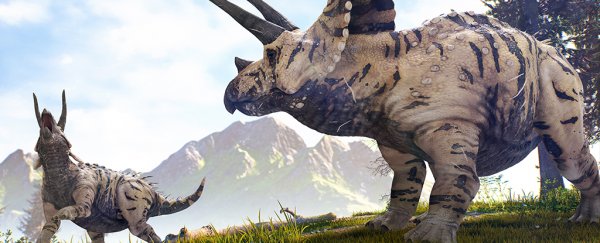When it comes to identifying which dinosaur remains come from a male or a female, palaeontologists often rely on the size and shape of the bones.
But one palaeontologist thinks researchers might have been a little hasty in their assessments, claiming that a lack of evidence supporting sex differences in many previously studied dinosaurs could mean we have it all wrong.
Sexual dimorphism is the technical way of saying the males and females of a particular species don't look the same, such as the size difference between male and female apes or the large fan of feathers on the male peacock.
Given it's so common across the animal kingdom, especially among crocodiles and birds, there's no reason to think dinosaurs would be exempt; but a dinosaur specialist at the Canadian Museum of Nature thinks the fossil record hasn't actually backed this up.
"I'm not saying that dinosaurs were not dimorphic, but I am saying that there's no existing fossil evidence to suggest that they were. The jury is still out," says palaeontologist Jordan Mallon.
Mallon went back through the journals to find past claims of sexual dimorphism and critically evaluated their sample sizes and statistical models.
While a number of studies suggest some form of size or frill difference among dinosaurs such as theropods, stegosaurs, and ceratopsians, only a few provided enough data to be tested.
One example of sexual dimorphism being attributed to a dinosaur can be found all the way back in the 1976 paper "Quantitative aspects of relative growth and sexual dimorphism in Protoceratops", which suggests the male form of Protoceratops andrewsi had broader frills and a larger bump on the nose than the female form.
Mallon found that in spite of a relatively large sample size, the paper's analysis didn't statistically add up to support its conclusions.
He also accuses many of the researchers of "begging the question" by first assuming sexual dimorphism exists and then working backwards to provide evidence, something that he states can be avoided by using the right statistical tools.
"Only mixture modelling methods are free from this assumption and should be used to study sexual dimorphism in the fossil record," writes Mallon in his paper.
While none of this categorically disproves the claims made by palaeontologists on the differences in size and shape between male and female dinosaurs, it does put us back at square one where we only have unsupported hypotheses.
"Essentially, if you go back and recrunch the data of those original studies using proper statistical tests such as mixture modelling, then there's no dimorphism", said Mallon.
This is just a single study, so it'd pay to see how the rest of the palaeontology community responds before deciding whether it's time to overturn past research.
None of this should be taken to mean it's impossible to distinguish dinosaur sexes, mind you.
Like birds, female avian-like dinosaurs probably had a layer of tissue called medullary bone inside some of the cavities of their skeleton which contributed calcium to egg production, providing one piece of evidence that could link other traits to a particular gender.
However for the most part, definitive fossil evidence separating the sexes is rare, leaving us to speculate.
The news comes just days after a Nature paper suggested a whole branch of the dinosaur family tree be chopped off and relocated.
And back in 2010, researchers suggested Torosaurus and Triceratops were actually just two different life stages in the same species, a claim that was later contested.
When all you have is a few rocks in the shape of old bones to understand the rich diversity of animals that roamed the planet for 165 million years, it's important to remember that our best interpretations of the evidence will often be subject to change, which is definitely a good thing for the off-again, on-again Brontosaurus.
This research was published in Paleobiology.
